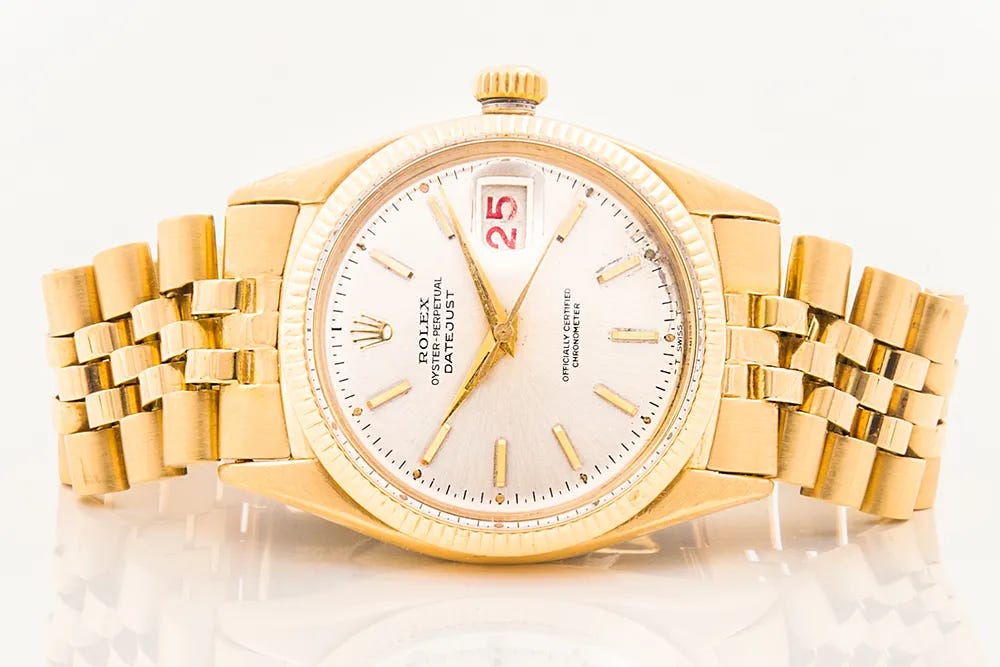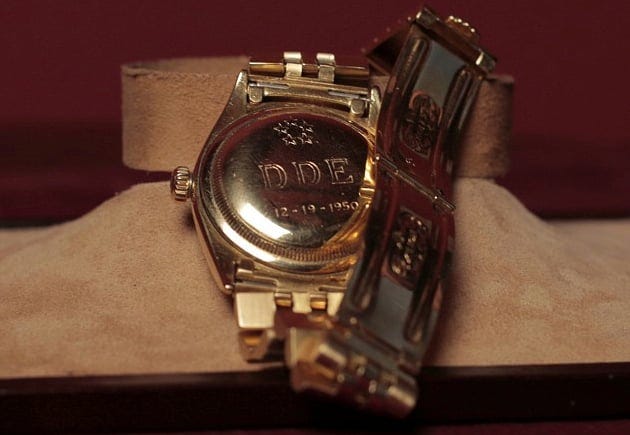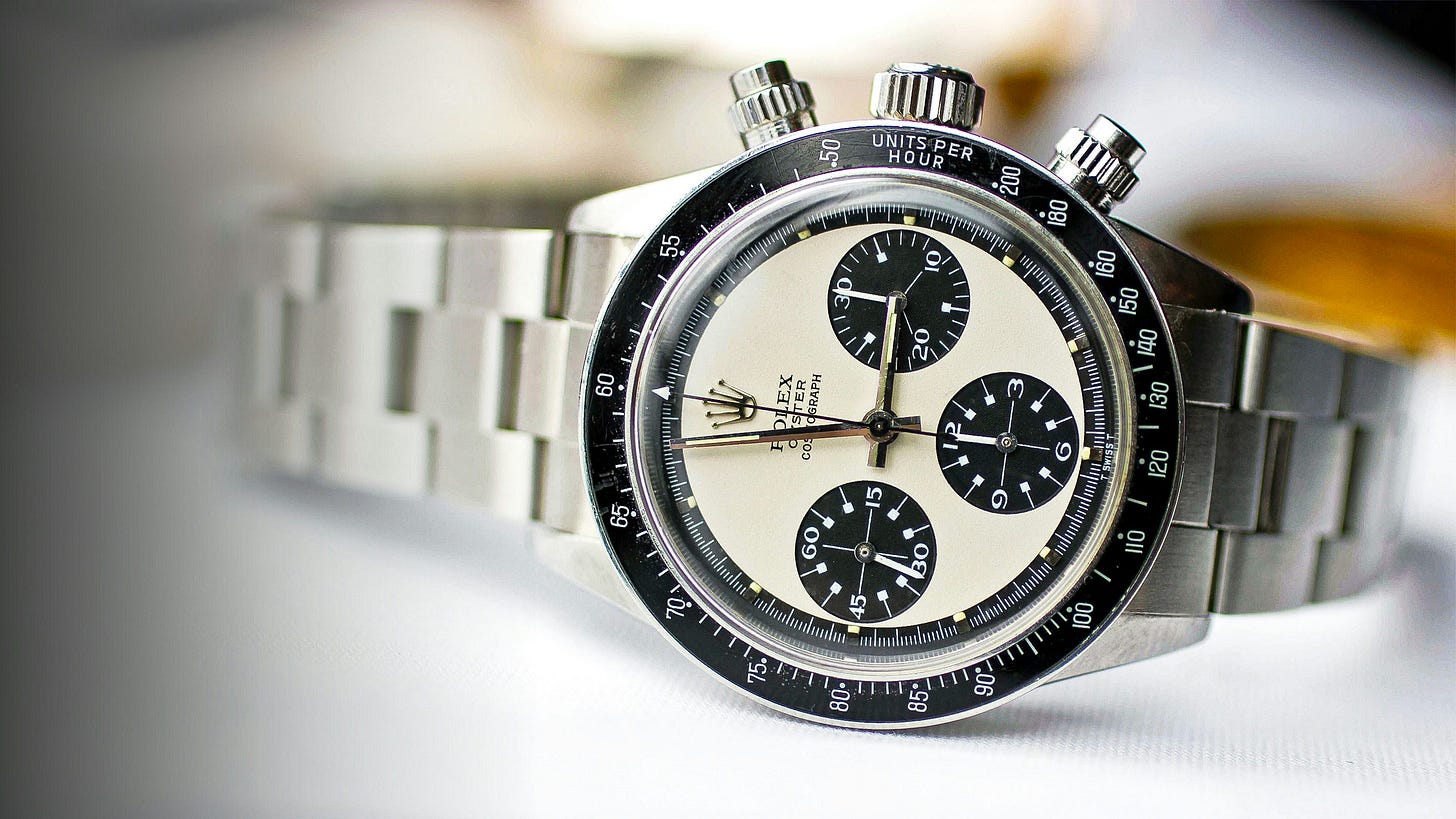crumb#006: Rolex and the Art of Getting to a President’s Wrist
How a Swiss timepiece became the unspoken badge of presidents, spies, and stars.
“When a man has a world in his hands, you expect to find a Rolex on his wrist.”
To write a line like that, and to make the world believe it, is no ordinary feat. Honestly, if you asked me how to even begin pulling something like that off, I’d probably shrug and say I have no clue. But that’s just one gem from a vault full of legendary taglines, crafted for legendary ads, featuring legendary people- an art Rolex has mastered like no one else. Wearing a Rolex isn’t just about telling time.
It’s a symbol. A signal.
A quiet, gleaming statement that you’ve arrived. That you matter.
But how did Rolex pull this off? It wasn’t the dominant player in the watch world back in the day- that title belonged to Omega. And not just by a small margin. Omega’s Speedmaster was the watch chosen for the Apollo 11 mission. Neil Armstrong wore one when he took humankind’s first steps on the moon. How do you top that?
How did Rolex become the go-to watch for world leaders?
How did it come to embody power, achievement, and permanence?
How did Rolex become Rolex?
The answer lies in a story as captivating as the outcome. It begins in the aftermath of World War II, when the world was still reeling from the destruction unleashed by one German- while another German was quietly crafting a legacy of his own. A story of sharp foresight, bold moves, and the precise execution of countless moving parts, all working in perfect sync.
Much like the movement of a Rolex itself.
Sometimes, things just make sense, don’t they?
Before diving into the real heart of this story, I can’t help but detour briefly into the origins of the company itself- and its founder, Hans Wilsdorf. Don’t worry, I’ll keep it short.
And yes, if the name Hans Wilsdorf doesn’t sound particularly Swiss to you, you’re absolutely right.
Hans was born in Kulmbach, Bavaria, on March 22, 1881. Orphaned at just 12 and sent off to boarding school by his relatives, he developed an early fascination with precision instruments and foreign languages- two passions that would end up shaping his future in unexpected ways. His twenties were formative: moving to Switzerland to work at a watch export firm, falling in love with the art and science of Swiss watchmaking, mastering global logistics, and spotting a growing appetite for wristwatches outside Europe.
In 1905, Wilsdorf co-founded a company in London with his brother-in-law, Alfred James Davis. They called it Wilsdorf & Davis. Davis brought the business acumen, handling finance and distribution, while Wilsdorf focused on the product. So far so good.
But wait, Wilsdorf was German, the company was British so where does Switzerland come in?
That answer lies in World War I.
Ask anyone what comes to mind when you say Switzerland, and aside from the scenic landscapes and the legendary watches, one word is bound to pop up: neutrality. During the First World War, Switzerland’s neutral stance made it a haven of stability. For a company founded by a German in London, that meant a safer, smarter place to be. It also meant escaping the heavy wartime import taxes Britain had slapped on foreign goods- not to mention gaining access to the finest craftsmen in the watchmaking world.
And as for the name Rolex? That came from a very different kind of inspiration. Wilsdorf admired the brand Kodak- a name that was short, punchy, easy to pronounce in any language, and memorable despite having no particular meaning. He followed the same logic, and out came Rolex.
Crisp, sleek, and one of the coolest brand names ever conceived. A perfect fit, really. Which always makes me pause and reflect on the brainstorming sessions I’ve had with friends, trying to name our own side projects. Let’s just say none of our ideas sounded or worked out even remotely well.
Sigh.
Alright, after that (shall we say) brief detour, let’s return to the story we came here for. We’ve already touched on the world wars and the chaos they unleashed- context that becomes crucial now, because this next chapter takes us into the aftermath of World War II. To rewind a bit: before World War I, pocket watches were the norm. But the trenches changed that. Soldiers needed timepieces that were hands-free and easily accessible. And so, WWI marked the beginning of the wristwatch era for men.
But the real turning point? That came with World War II. By then, wristwatches were becoming more common- but it was the war that truly pushed their evolution. Military operations across land, sea, and air demanded precise coordination. Watches had to rise to the challenge: rugged, water-resistant, anti-magnetic, and easy to read even in dim light. In many cases, a functioning watch could mean the difference between life and death.
And when the war ended, the watches came home with the soldiers. They weren’t just timepieces anymore. They were relics of struggle, symbols of survival, reminders of days that felt endless and nights that seemed eternal. They became heirlooms. Collector’s items. Emblems of duty, precision, and resilience. Everyone wanted one.
It’s now 1945. The war is over. And Rolex, to mark the 40th anniversary of Wilsdorf & Davis, releases a new model, arguably their most beautiful yet: the Datejust.
That same year, a man named Henri Guisan retired as a national hero in Switzerland. Until I started researching this, I honestly didn’t know much about him. Guisan was the General of the Swiss Armed Forces- a title granted only in times of war or national emergency. During WWII, he was the face of Swiss resistance and strategy, credited with preserving the country's independence and democracy during one of the darkest periods in modern history.
And right around this time, Rolex produces its 50,000th officially certified Swiss chronometer. It’s a Datejust. Hans Wilsdorf decides to gift that milestone watch to General Guisan in recognition of his wartime service- and Guisan happily accepts.
This gesture wasn’t just a mark of gratitude- it was also one of the first in a series of strategic moves that would define Rolex’s approach for decades to come, as we shall see.
Moving on, now, while I didn’t know much about General Guisan, I’m guessing most of you have heard of the next figure in this story. In fact, some of you, like me, live in countries still shaped by his legacy
By the time World War II began, he was already a seasoned politician and soldier. His résumé? Impressive, to say the least: President of the Board of Trade, Home Secretary, First Lord of the Admiralty during World War I. He was a man who divided opinion, who wielded oration like a weapon, who forged critical alliances with the likes of Roosevelt and Stalin. Though not a battlefield commander, he was deeply involved in military planning- including the D-Day invasion of Normandy.
And after the war? He casually added the Nobel Prize in Literature to his list of achievements in 1953. (Yes, literature- just a side quest for him, apparently.)
You’ve guessed it by now. The man is Winston Churchill.
Meanwhile, back at Rolex HQ- hot on the heels of gifting their 50,000th certified chronometer to Guisan- the company ramps up production and hits yet another milestone. A few months later, they’re ready to unveil their 100,000th officially certified Swiss chronometer.
With another masterstroke of networking, this is where Rolex truly doubles down. Following their strategy to associate with figures of great merit during the war, Wilsdorf decided to gift that watch to Churchill. Climbing the ladder, a step at a time.
And just like that, Churchill receives a Rolex: an Oyster Perpetual Datejust in 18k gold, with a fluted bezel, white dial, and jubilee bracelet. In a matter of months, two of the most prominent names of World War II- Guisan and Churchill- were now wearing Rolexes.
But the story doesn’t end there. There’s still one final piece. One last link in the chain.
If you look up the cover of Life magazine dated July 12, 1952, you’ll see it.
A man seated confidently in a classic wooden armchair, radiating calm authority and dignified charisma. He’s dressed in a tailored, double-breasted grey suit, a crisp white shirt, and a subtly patterned tie. His left arm rests casually on the armrest, catching the light. On his wrist? A gold watch.
The man is Dwight David “Ike” Eisenhower.
In 1951, Rolex manufactured their 150,000th officially certified Swiss chronometer (and no prizes for guessing where I am going with this one now). Naturally, Rolex wanted a recipient worthy of this, someone who not only signified everything that Rolex wanted a wearer to signify: power, status, leadership; but in this case, also someone who would get them an entry into the limitless potential of America and the American market.
And they envisaged Eisenhower to be that man given his role as the Supreme Commander of the Allied Expeditionary Forces in Europe during World War II. Through a series of communications involving Rolex’s Director René Jeanneret, a mutual acquaintance named Nana Rae, and General Eisenhower’s office, the company inquired whether the General would be open to receiving a gift. General Eisenhower responded with gracious acceptance- why wouldn’t he, his friend Winston Churchill wore one, how could he fall behind?
Arguably one of the most iconic watches of the 20th Century, Eisenhower’s Rolex Datejust, reference 6305, was a 36mm yellow gold timepiece with a matching Jubilee bracelet. Its silver dial featured a red date display under the signature Cyclops magnifier. The caseback was custom- engraved with five stars for his rank, his initials “D.D.E,” and the date 12-19-1950, marking his appointment as NATO’s Supreme Commander. His initials were also subtly engraved on the bracelet clasp, adding a personal touch to this iconic gift. And with this gift, Rolex had cracked it.
Eisenhower would ultimately go on to become the 34th President of the United States in 1953. Rolex would be worn by the most powerful man on the planet, setting in motion a craze for their watches which is hard to quantify.
From the wrist of a five-star general to the silver screen’s most charismatic spy, Rolex’s ascent wasn’t just remarkable- it was cinematic. When Sean Connery’s James Bond coolly checked his Rolex Submariner- whether while defusing a bomb, seducing an informant, or ordering a martini- the world wasn’t just watching a fictional secret agent. They were witnessing the embodiment of timeless style. In Bond’s world of danger, luxury, and moral ambiguity, the Rolex wasn’t just a prop- it was a character in its own right. It said something about who he was: precise, unflinching, unforgettable. In that moment, Rolex ceased to be just a timekeeper. It became the timepiece of legends.
Enjoying these curious crumbs?
If today’s story left you smiling or wondering, just tap to recommend it to a fellow explorer. Every crumb you share helps our little trail grow!
What began as a symbol of wartime valour and resilience now shimmered with mystery, charisma, and effortless charm. Everyone wanted to wear what Bond wore- not simply for the accuracy, but for what it meant. To wear a Rolex was to carry a bit of Bond’s cool, a slice of that confidence, that legacy.
And if one cultural conquest wasn’t enough, the Rolex Daytona took things even further. Particularly the now-mythic “Paul Newman” variant- named for the actor, race car driver, and all-around American icon who made it famous. On his wrist, the watch was more than a tool; it was a statement. Of speed. Of elegance. Of a kind of rebel glamour that didn’t shout, it smirked. The Daytona became a holy grail for collectors, a symbol of an era where style and substance shared the same pulse.
With every tick, Rolex wasn’t just keeping time- it was shaping history. Turning wrists into runways. Turning wearers into icons. Today, Rolex stands not just as a luxury brand, but as a global institution. A badge of excellence, endurance, and arrival. It whispers in auction houses. It commands respect in boardrooms. It glints under the cuffs of presidents, explorers, artists, and dreamers.
And in an age where technology changes by the second and trends evaporate overnight, Rolex remains gloriously indifferent; unmoved, timeless. At once a relic of the past and a beacon of prestige in the present.
It is not just worn. It is earned.
And that, as they say, brings us to the end. Although, if I’m being honest, I wandered down a few unexpected rabbit holes while writing this- digressions I hadn’t planned, but couldn’t resist.
There are still so many stories left untold. The more you read about Rolex, the deeper you fall into its myth. And the more you fall in love with this extraordinary brand, the more you might find yourself quietly hoping maybe one day, one of those legends will sit on your wrist too.
Until next time.






Did not know Rolex had this much history! Omg